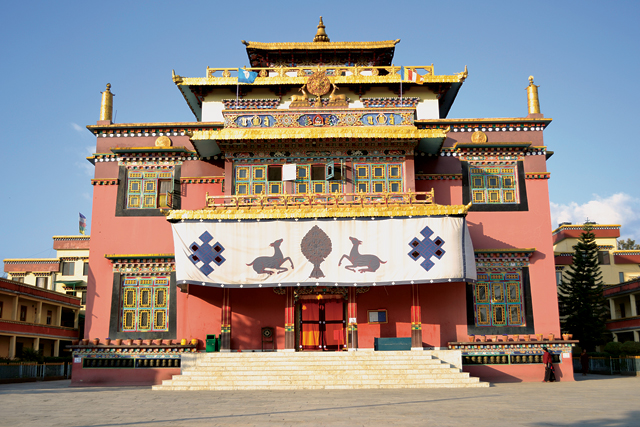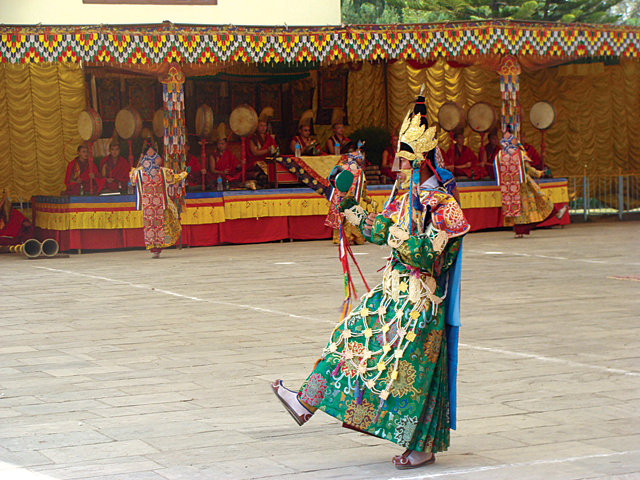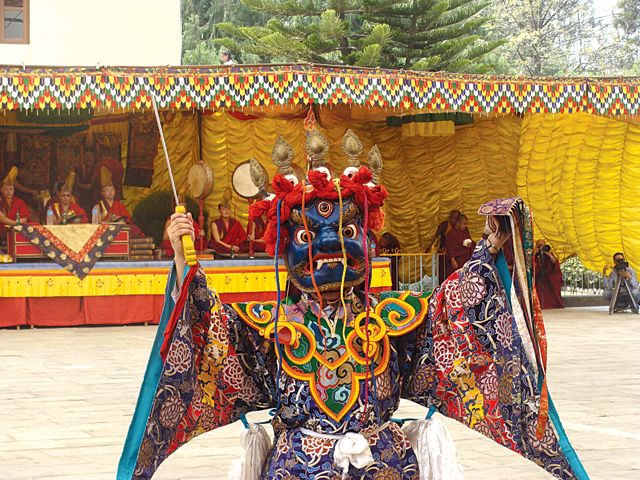An ancient center of learning flourishes in a new location.

The mass exodus from Tibet, following the 14th Dalai Lama’s escape, was like a tide that washed great spiritual masters into the outer world. One such person was the lama Dilgo Khyentse Rinpoche. He fled from Tibet to Bhutan, where he became spiritual advisor to the royal family and teacher to Jigme Singye Wangchuck, former king and father of the present King of Bhutan.
Khyentse Rinpoche also taught His Holiness the Dalai Lama. “He was one of my important gurus. I found in him those very good qualities described by the Buddha. He was a very good scholar and a very good practitioner,” the Dalai Lama has said of Khyentse Rinpoche. Sogyal Rinpoche, author of The Tibetan Book of Living and Dying, described Khyentse Rinpoche as a man in whom “all of Tibet’s Buddhist heritage was embodied.”

Like so many other Tibetans that fled their homeland, Khyentse Rinpoche was deeply concerned about the threat to Tibetan culture and heritage. He therefore continued to teach Tibetan Buddhism in Bhutan and elsewhere. His total works, consisting of commentaries, poems, and writings, amount to 10,000 pages. He traveled to Europe and the U.S. to share the deep insight into Tibetan Buddhism he had developed through great diligence and hardship while in Tibet. In 1985, he returned to Tibet after nearly three decades, and visited dozens of monasteries. It was through his tireless efforts that the Samye Monastery, Tibet’s oldest monastery, was renovated.
Khyentse Rinpoche stood out amongst the gurus of the past century as much for his knowledge and mastery of religious scriptures as for his inclusive approach to the protection and propagation of Tibetan Buddhism. “His basic attitude was non-sectarian, which I very much appreciate,” says the Dalai Lama. In 1980, Khyentse Rinpoche began construction of the Shechen Monastery near the Boudhanath stupa. It took 12 years to build. Today, the monastery stands as a symbol of Khyentse Rinpoche’s vision and philosophy, and his desire to preserve Tibetan culture.

The clearest and most visible sign of the non-sectarian approach of Khyentse Rinpoche is on the inner walls of the monastery, which is covered with frescoes of tales of Tibetan Buddhism and the leading teachers of its four main schools. It is named after the original monastery located in Eastern Tibet, which has been rebuilt and now stands in the present-day Sichuan Province. It was in that monastery in Tibet that Khyentse Rinpoche had trained and studied under some of the most revered and learned Buddhist gurus of the time. Khyentse Rinpoche established Shechen Monastery to give a new lease of life to the culture of eastern Tibet and to transplant, as it were, the traditions that had once flourished in the mother monastery.
Khyenpo Shelnang, one of the teachers at Shechen, remembers the location before its construction began. “This was a scary place. There was a small pond and a cemetery. There used to be snakes. People were scared to pass through here even in daylight.” Nothing of that rustic surrounding or macabre location remains today. The Shechen Monastery premises today are a splendid example of Tibetan architecture. The united efforts of workers and artists from Bhutan, Tibet, India and Nepal have created one of the most beautiful monasteries in Nepal.
Shechen Monastery has a strong Bhutanese connection. Much of the furniture, paintings, and statues were either brought from Bhutan or made by Bhutanese artists and craftsmen in Nepal. These were gifts from the Bhutanese royal family. “During a recent visit to Bhutan, some old teachers who had been here during the building of the monastery told me that even the concrete used here was brought from Bhutan,” says Khyenpo Shelnang. For these reasons, the monastery was known among some locals as ‘Bhutan Gumba.’
On any given day, the spacious courtyard of the monastery is filled with a throbbing and clanging drifting from the main prayer hall. Slippers and flip-flops, belonging to the more than 500 resident monks, form the first step on the wide flight of stairs that reaches the prayer room. There, monks chant the same ancient mantras that once Khyentse Rinpoche must have chanted.
A Place For Scholars
Shechen Monastery is a pilgrimage site of sorts for those devoted to research and study. There is the monastery’s impressive archive that houses rare texts, paintings, photographs, and negatives. Also preserved in the climate-controlled room of the archive are photographic gems. Shechen has 12,000 color negatives of Tsagli, miniature paintings. The monastery provides copies of these photos, which were taken in the late 1980s, to scholars and other monasteries on demand. Shechen’s archive also contains more than a thousand original slides of photographs of thangka paintings, statues, and other artifacts. Several thousand photo slides of monasteries, sacred sites, and portraits of famous Tibetans are also stored here. There are also videos depicting Tibetan ceremonies, revered gurus and culture. Scholars can also access the three hundred hours of Dilgo Khyentse’s teachings stored in the archive.
Shechen Monastery is one of the most important centers of Buddhist studies in Nepal. Novices begin their training in an elementary school, studying Tibetan, history, English, Nepali and other subjects. After six years of such schooling, the students embark on a two-year training period in rituals, dance, and drawing mandala. At the end of this period, Shechen’s many specialized courses become available to the monks. They can either continue their practice of the rituals, which entails a two-year course plus an additional optional two years at the end of it. The other choice is the Tsering Art School, which offers a six-year course in thangka painting. Then there is the specialized course in philosophy taught at the Shechen Institute of Higher Learning (Shedra in Tibetan), a nine-year program that involves studying ancient texts, tantra, debating, regular examinations and long periods of meditation. “We are constantly monitoring and assessing the students to identify potential teachers from the student body,” says Khyenpo Shelnang. The selection of teachers begins in the sixth year.
The Shedra is the equivalent of an Ivy League university. Shechen Monastery’s library is one of the largest Tibetan language libraries in the East. Among the thousands of book housed here are 25 volumes of Khyentse Rinpoche’s works and 27 volumes of the teachings of Mipham Rinpoche, one of the most revered teachers of the Nyingma lineage.
The monastery is also a center of novel educational practices. “Our monastery focuses a lot on education, especially science,” said Khyenpo Shelnang. In 2013 the monks of Shechen organized a three-day exhibition on the five physical senses. “We presented a fusion of science and Buddhism in that exhibition. Using diagrams, both scientific and Buddhist perspectives were explained.” The monastery plans another exhibition on climate change.
Art for All
The Shechen Institute of Traditional Tibetan Art, Tsering Art School, was established in 1996 by Shechen Rabjam Rinpoche. Here, students train in ancient Buddhist thangka painting. Dilgo Khyentse Rinpoche had chosen the painting master Konchog Lhadrepa to study the Karma Gadri style of painting in Rumtek, Sikkim. This form of art has its roots in eastern Tibet and is characterized by spacious landscapes and light colors. Lhadrepa is one of the main teachers at the Tsering Art School. Monks, nuns, laymen and women and foreigners can train here.
Shechen is known to many people as the venue of the famous Tsechu Cham, or ‘Festival of the Tenth Day,’ which marks the birthday of Padmasambhava or Guru Rinpoche. Although his birthday falls on the tenth day of the fifth month of the Tibetan calendar, which is the date for celebration of the Tsechu Cham in Tibet, at Shechen it is celebrated on the tenth day of the second month. Since the fifth Tibetan month falls around the hot and rainy month of July, the festival was moved to the pleasanter weather of spring.
“This dance is not just about culture. It is part of our spiritual practice,” says Khyenpo Gyurme Tsultrim. “These dances were a very secret practice in ancient times, performed by great yogis as part of their spiritual training. They were performed at special times and in the presence of only a select few. But that aspect of the dance evolved when Buddhism traveled to Nepal and Tibet.”
The Tsechu Cham is a choreographed retelling of Guru Rinpoche’s exploits in his eight different manifestations. It started in the twelfth century after Guru Chowang had a vision in which he traveled to Guru Rinpoche’s heavenly abode, where he witnessed a performance of the dance. Perhaps it is this ancient and spiritual aspect that makes it a profoundly moving experience for those who see it. Khyenpo Gyurme says the dance has a religious and cultural importance. “Buddhists believe that witnessing such events earns one spiritual merit. Its cultural importance is that it brings people together. In remote regions, where social gatherings are rare, festivals such as these provide the people with an opportunity to meet and celebrate.”
Visiting Shechen Monastery is witnessing the spiritual heritage of Tibetan culture and a peek at the intriguing world of Tibetan Buddhism . Like a Buddhist parable on impermanence, it reminds one of loss, while on the other hand, proves that things that are important somehow linger, in different times and locations.










